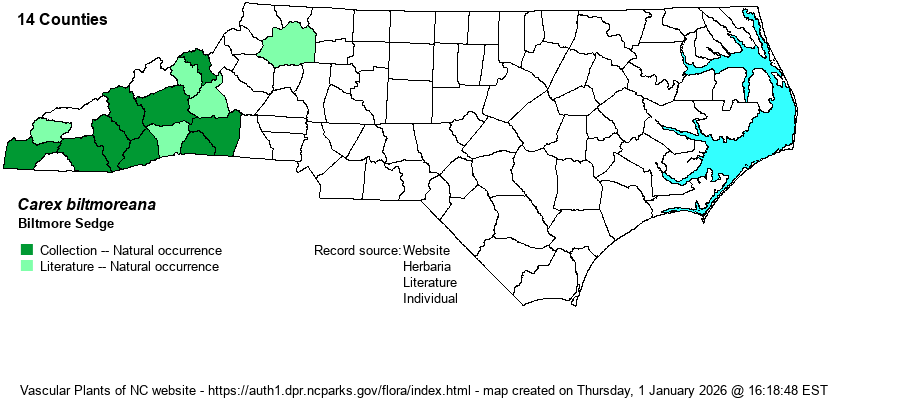| Author | Mackenzie | |
| Distribution | Central and southern Mountains; and verified from Doughton Park in Wilkes County in 2023. Specimens from Montgomery County are misidentified and actually belong to C. impressinervia.
Endemic to southwestern NC, northwestern SC, and northeastern GA. | |
| Abundance | Frequent; often common or dominant where found. Formerly -- in the days of RAB (1968) -- this was considered a very rare species, not just in NC but globally; there were just 3 counties listed in NC for it in that reference. Obviously, much more survey work in more remote high elevation areas with rocky crags and peaks has uncovered many newer populations. It is now properly treated only as a Watch List species by the NCNHP. | |
| Habitat | Granitic domes, rock outcrops, and in adjacent woodlands -- at middle and high elevations; in all cases in thin soil moistened by surface seepage. |
| Phenology | Flowering and fruiting May-June. | |
| Identification | Biltmore Sedge occurs in clumps or patches of leaves up to 1.5 feet long, with stems up to 2.5 feet long that usually arch over. Its robust size and cool, rocky seepage habitat are clinchers. | |
| Taxonomic Comments | None
The genus Carex is the largest in North America, and among the largest in the world. In temperate and boreal regions, Carex is often the dominant or co-dominant ground layer in many habitats. Seeds (achenes) are valuable food for birds and small mammals, while foliage is used by birds and mammals to make nests and as food by mammals. Species of Carex often look vastly different from one another -- spikes erect vs. drooping, tiny inflorescence vs. whopping, culms leafy vs. naked, perigynia beaked vs. beakless, stems densely bunched vs. single, etc. The genus has been divided into many sections (or groups), based on shared characters; some taxonomists have suggested that these be different genera, but that proves unworkable (so far). All Carex share the feature of a perigynium (an outer covering) which completely surrounds the achene (seed). This covering may fit tightly or loosely (like a small bladder), depending on which group or species. Details of perigynia shape, ornamentation, presence and size of beak, number of striations (or veins) are all important ID features. In recent years Rob Naczi and colleagues have stressed the importance of arrangement of perigynia -- whether spiral (3+ ranks) or distichous (2-ranked) -- and have named a number of new species as well as split off some older synonyms. Therefore, RAB's (1968) key, excellent for its time, can only be used in a general way today. Members of some sections of Carex are difficult to key out (notably Ovales, Laxiflorae, Griseae); this is in part due to variation among individuals of a species, or failings of the key. FNA has drawings of most species and some species may be found in two or more places within a key, to acount for variability. New species to NC, and new to science(!), continue to be found in NC. | |
| Other Common Name(s) | Stiff Sedge, Granite Dome Sedge | |
| State Rank | S3 | |
| Global Rank | G3 | |
| State Status | W1 | |
| US Status | | |
| USACE-agcp | | |
| USACE-emp | | |

